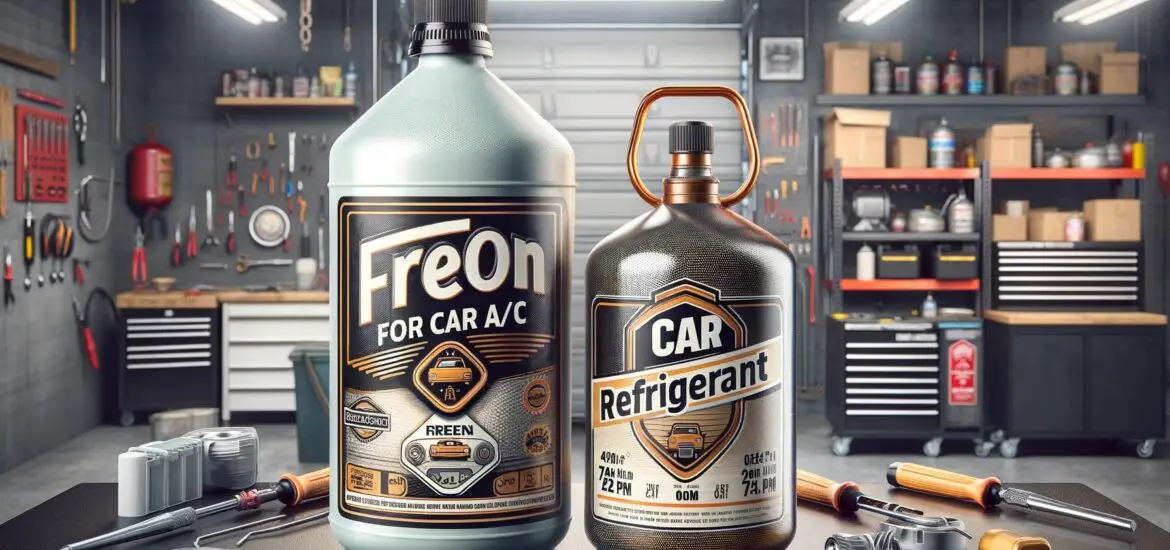This comprehensive guide will compare freon vs refrigerant for car to clarify their differences, enabling you to make informed decisions for your automotive cooling needs.

Table of Contents
What is Freon?
Freon is a brand name commonly used to refer to a group of refrigerants, including chlorofluorocarbons (CFCs) and hydrochlorofluorocarbons (HCFCs). It was widely used in automotive air conditioning systems for decades.
Freon, particularly R-12, was known for its excellent thermal transfer properties, making it highly effective in cooling vehicle interiors. However, its production and use have been phased out due to environmental concerns.
The major drawback of Freon is its high potential to deplete the ozone layer, a critical shield that protects the Earth from harmful ultraviolet radiation. The release of Freon into the atmosphere, especially from leaks in car AC systems, has contributed significantly to ozone depletion. This has led to increased health risks like skin cancer and environmental issues such as climate change.
Modern Refrigerants: The New Norm
Modern refrigerants have been developed to replace Freon in automotive air conditioning systems. These include hydrofluorocarbons (HFCs) like R-134a and hydrofluoroolefins (HFOs) like R-1234yf.
Unlike Freon, these newer refrigerants are formulated to have minimal impact on the ozone layer and lower global warming potential. R-134a became the standard in the auto industry following the phase-out of Freon. More recently, R-1234yf has been gaining popularity due to its even lower environmental impact.
These modern refrigerants are the result of extensive research and development. The aim is to achieve a delicate balance between environmental safety and operational efficiency in car air conditioning systems.
Freon vs Refrigerant for Car
Understanding the fundamental differences between Freon and modern refrigerants is key to making the right choice for your vehicle. Here, we’ll explore these differences across various aspects.
Environmental Impact
The shift from Freon to modern refrigerants is largely driven by environmental concerns. Freon, particularly the R-12 variant, has been a significant contributor to ozone layer depletion.
In contrast, modern refrigerants like R-134a and R-1234yf have been developed to minimize this impact. R-134a does not deplete the ozone layer, although it does have a higher global warming potential.
On the other hand, R-1234yf represents a significant advancement in this area. Its global warming potential is drastically lower than that of R-134a. This makes it one of the most environmentally friendly refrigerants currently available for automotive use.
Cooling Efficiency
Cooling efficiency is a critical factor in the performance of car air conditioning systems. Freon, particularly R-12, was known for its exceptional cooling capabilities.
However, modern refrigerants like R-134a and R-1234yf are engineered to provide comparable, if not superior, cooling performance. These refrigerants work efficiently across a range of temperatures and pressures, suitable for modern car AC systems.
They facilitate effective heat transfer, ensuring that the vehicle’s interior remains cool and comfortable. This is evident even in extreme weather conditions.
Vehicle Compatibility
Vehicle compatibility with refrigerants is a key consideration. Older vehicles, typically those manufactured before the mid-1990s, were originally equipped with AC systems designed for R-12 (Freon).
However, due to environmental regulations, these vehicles can be and often have been, retrofitted to use the more environmentally friendly R-134a. It is essential to note that retrofitting requires modifications to the AC system, as R-12 and R-134a are not directly interchangeable.
Newer vehicles are designed to operate with R-134a or R-1234yf. As such, they are not only more eco-friendly but also align with the latest automotive technology and environmental standards.
Cost Implications
The transition from Freon to modern refrigerants can involve initial costs, particularly if retrofitting older vehicles. Retrofitting includes replacing or adjusting components like the compressor, condenser, and hoses to be compatible with newer refrigerants.
However, this cost is an investment in environmental sustainability and long-term efficiency. Modern refrigerants, being more environmentally compliant, can also reduce the risk of penalties associated with environmental regulations. Moreover, their improved efficiency can lead to reduced energy consumption and lower operating costs over time.
Making the Right Choice for Your Car
Choosing the right refrigerant for your car involves considering environmental impact, cooling efficiency, vehicle compatibility, and cost implications. It is advisable to consult with a professional mechanic to assess the specific needs of your vehicle. They will ensure that any transition to a new refrigerant is done correctly and safely.
An informed decision will not only enhance the performance of your car’s air conditioning system but also align with global environmental standards. This, in turn, will contribute to the broader effort to mitigate climate change and protect the ozone layer.